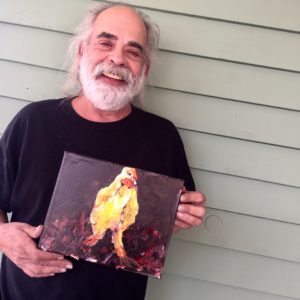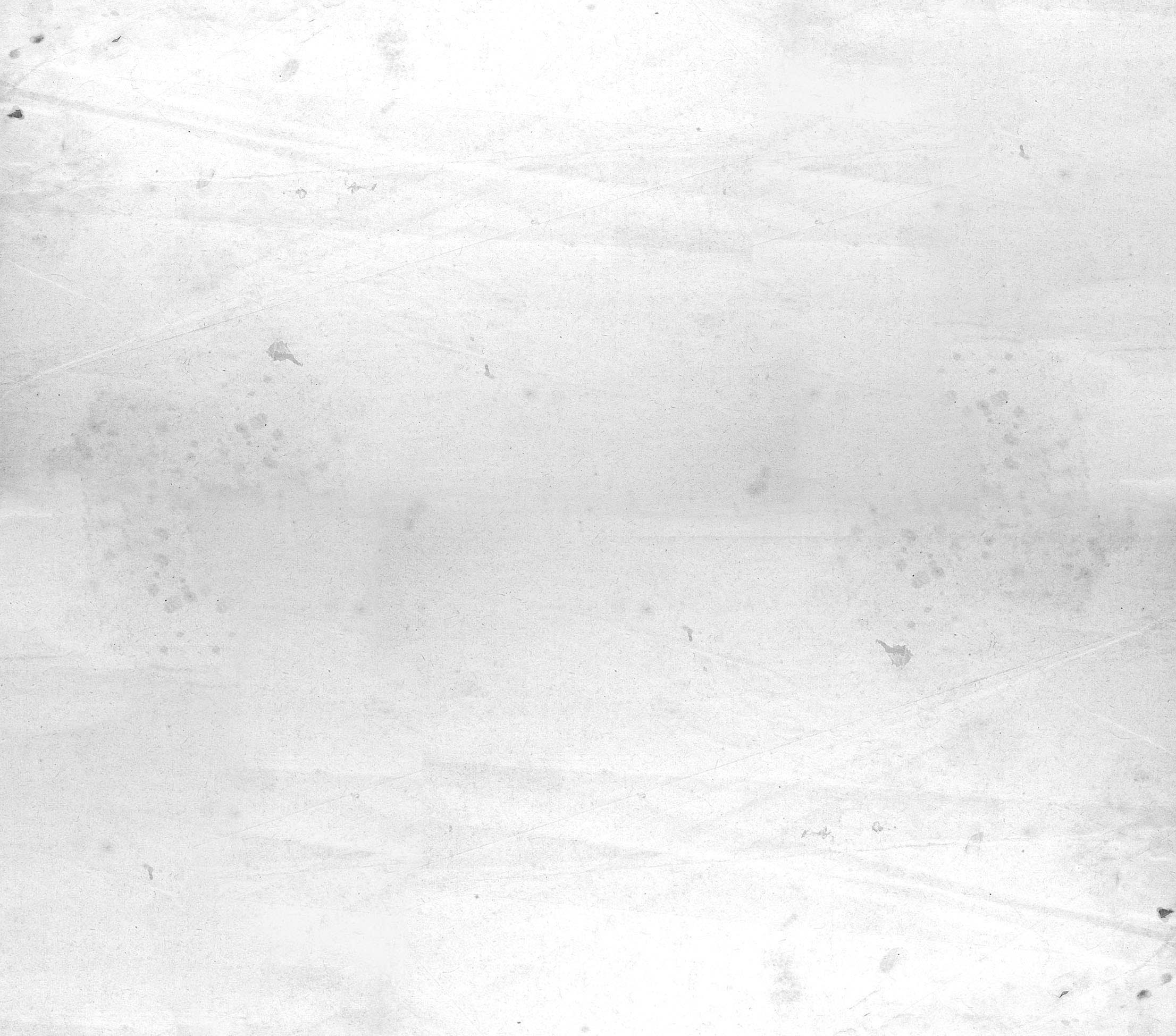12 Feb Take Two Art Classes and Call Me in the Morning
Noblesville Creates explores the therapeutic power of art
We rely on innovations in medical technology and medicine to solve most of the physical traumas, diseases and minor ills that plague us. But when it comes to our mental health, traditional therapies aren’t always the right answer. In some cases, art is at least part of the answer.
In February and March 2019, Noblesville Creates is exploring art beyond its aesthetic qualities to demonstrate the healing power of art. Through Feb. 28, 2019, the public is invited to see Michael J. McGuire’s paintings in the Stephenson House gallery at Noblesville Creates. The quality of his work doesn’t allude to the fact Michael has been painting for less than three years.
“Talking is hard,” he said in a recent phone interview. By his side, his wife Megan helped make sure he was heard. It hasn’t always been hard for him to communicate. In the years before October 10, 2015, Michael had no trouble, but at 3 a.m. on that date, he awoke confused and not speaking clearly. Megan drove him to the emergency room.
After a CT scan, the doctor said Michael had bleeding on his brain. He was transferred to a neurology intensive care unit and diagnosed with Dural Venous Sinus Thrombosis. Two days later, he was rushed into emergency surgery to reduce severe swelling and pressure on his brain. A portion of his skull was removed (decompressive craniectomy). The surgery saved his life.

Artist Michael J. McGuire at work.
Michael spent 20 days in intensive care, seven days on the “acute neurology” floor, and 40 days at a rehabilitation hospital, where he learned how to walk and eat again, with much success. However, since his brain injury, Michael has aphasia, where he knows what he wants to say, but he has trouble thinking of the right words to speak.
One year later, during an aphasia support group at Butler University, he picked up a paintbrush. Before his trauma, Michael traveled for his medical sales job, working long hours and focusing on his career and his new bride. He had never explored any potential artistic talents. A paintbrush was new to him, but something happened when he began to use it.
Art gave Michael a new language with which to express himself. He “speaks” art better than most of us, and has found success as an acrylic painter, giving him a second career to help provide for his family. While his passion is abstract art, his body of work includes contemporary, still life, faith-based and nature-themed works, to name a few.
“The response from people has been really cool,” Megan said. “It’s an amazing way to share his story. It’s like art was locked up inside him and now it’s unleashed.”
Art was also unleashed in an unlikely place in response to the school shooting at Noblesville West Middle School. When a 13 year old opened fire on May 25, 2018, student Ella Whistler and teacher Jason Seaman sustained devastating bullet wounds, but they were far from the only victims. Many of the more than 1,300 students at NWMS suffered, and continue to suffer.
Disasters such as school shootings have been associated with post-traumatic stress reactions, depression, anxiety, difficulty sleeping, resistance to school, inability to trust, fear, decline in academic performance, anger, hyper-vigilance and guilt.
During the days following the Noblesville shooting, eight art therapists were among the professionals on hand to help students begin to heal. Jim Beitman was there. He has worked as an art therapist since 1976, developed the first art therapy program in IU Health’s mental health unit and teaches pre-art therapy at the University of Indianapolis.

Art therapist Jim Beitman helped NWMS students heal.
“It was a real emotional experience,” Jim said of his time spent with NWMS students. “They had blocked off the wing of the school where the shooting had taken place so no one had to walk by that place. The students needed to get together and be strong together.”
When words were hard to come by, art stepped in to allow kids to open up and help them share their feelings. As paint and markers were picked up, posters and banners took shape.
“We provided a safe environment for them to be honest and share their feelings of fear, insecurity — the incredulousness of it,” Jim said. Students wrestled with how the tragedy could have happened. They wondered if it really did happen to them and their best friends. The “Noblesville Strong” mantra emerged. Students from other schools around the county sent posters of support.

Bonnie Ramirez’s piece for “Heart Art”
During this time, an existing project involving Noblesville Creates, the City of Noblesville and the Noblesville Cultural Arts District illuminated the desire for connection to one other and our community. In the spirit of celebrating local places, people and experiences, the “Heart Art” project includes public art pieces by eight professional artists. Look for the art at various downtown locations: Noblesville Main Street, Matteo’s, Li’l Bloomers, All Local, Noble Coffee & Tea and BlueSky Technology Partners.
Through the month of March 2019, Jim and other artists will take part in “Process: Exploring the Healing Power of Art” at Noblesville Creates. The exhibit in the Judge Stone House gallery will feature expressions of art’s role in tackling difficult emotions and grief, and improving mental health.
Art therapy is often part of a more comprehensive mental health treatment program carried out in individual or group settings. Its impact, Jim said, depends on a person’s circumstances and objectives.
“Goals are different for every person. They can be little changes or take someone in a whole new direction. Art is very nonthreatening. For many artists, it’s not so much the finished pieces that are healing, but the process of thinking and problem solving,” he said.
Cassie Dobbs, who participated in a past Noblesville Creates exhibit, is an art therapist at Riley Hospital for Children and president of the Indiana Art Therapy Association. She said the 40-50 member organization is constantly in education mode to help people understand art therapists’ role and qualifications. Cassie is an art therapist at Riley Hospital for Children, helping patients facing major physical challenges, from cancer to heart disease.

Cassie Dobbs is president of the Indiana Art Therapy Association.
“Art therapists aren’t curing a medical illness, but we know that medical wellness is directly related to mental wellness. We are lucky at Riley to be highly valued. Art making is inherently healing, and creates a therapeutic relationship,” Cassie said.
Exhibiting art derived from mental health sessions is a big topic in the art therapy community, she added. Does it change the art’s meaning to have a very intimate thing that happened in a therapy session put on display? To answer that question in part, Riley hosts an annual show to allow patients and families to share their stories, which can be very empowering, Cassie said. Through their art, they can better control what their story is and how it’s interpreted.
The process people move through as they execute an art project takes them in new directions, Jim said. People see their lives life in pictures, like others look at a photograph. For the March show at Noblesville Creates, expect to see lots of iterations of his vine ripened tomatoes. He hopes visitors to “Process: Exploring the Healing Power of Art” see the connections among the art and what’s important in their own lives.

